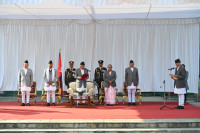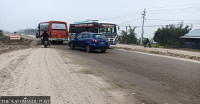National
Basant Raj Mishra: ‘It’s time we started planning properly to welcome tourists’
The tourism entrepreneur on Covid-19 impact on Nepal’s tourism, government’s haphazard decisions and way forward.
Sangam Prasain
Tourism is one of the hardest hit sectors by the Covid-19 pandemic. The four-month-long lockdown from March 24 to July 21 meant no no flights to Nepal, resulting in zero foreign tourists in the country in the peak tourist season. Even though the government on July 21 said that flights will resume starting September 1, it revised its decision last week. International passengers flights will resume from September 1 but the government has said tourists won’t be allowed. Tourism contributes nearly 8 percent to the country’s economy and it is a major foreign currency earner for Nepal. The Post’s Sangam Prasain talked to tourism entrepreneur Basant Raj Mishra, executive chairman of Temple Tiger Group of Companies and past president of the Nepal Association of Tour Operators, the representative body for tour operators in Nepal, about the pandemic’s impact on tourism sector and its revival and ways to draw tourists in the near future.
Is the government not confident about reopening tourism immediately?
It seems so. We have been requesting the government to set up a PCR testing centre, either funded by the private sector or the government itself, at the Kathmandu airport. The idea behind a testing centre at the airport is to do quick testing. There are “express test” machines available that can produce reports quickly. If it’s negative, no isolation required. The airport testing for Covid-19 has gained traction in most of the countries now. This would have not only allowed travellers to bypass mandatory quarantine when they landed here but would have also reduced the threat of importing infections. In many countries including Europe, a PCR test certificate is more than enough. At home, with some strict health and safety protocol, we were expecting to host some tourists, especially in mountain tourism. But now everything is gone. Spring tourism has been wiped out and there are no hopes of autumn tourism. We have to prepare for the spring 2021. The way the government is responding to the tourism industry, everything, however, still looks uncertain.
Is the government making haphazard decisions?
Everyone is confused about the government's decisions. Nepal Airlines Corporation flew to bring stranded Nepalis a few days back but returned empty because the government decided to stop all repatriation flights. But on the same day, Turkish Airlines was permitted to land with passengers. This is an example of a lack of planning and vision of the government. Obviously, it’s difficult to make a solid plan in such times. But at least efforts should be made. Without proper planning, the industry may face several unwanted and unexpected impacts.
There are concerns that the government has not used experts' views while planning. Is that the reason behind haphazard decisions one after another?
Both ruling and main opposition parties were involved in their internal problems right from the beginning. As a result, the country’s economic agenda took a back seat. For example, in mid-July, the government announced a fund worth Rs50 billion through which badly affected sectors like tourism and micro, small and medium enterprises were to get loans at a 5 percent interest rate for reviving the enterprises and paying staff salary. The timely utilization of this fund can provide an impetus. But Nepal Rastra Bank formed a committee in mid-August and the fund has not been released yet, and we are already past the third week of August. This kind of decision, for the country like Nepal, where national economies rely on a small number of services and industries, is deeply worrying.
Where is the problem? What’s the roadmap?
No one knows what’s the roadmap. The only plus point in tourism is people are willing to travel. We don’t have to assure 100 percent safety. Even if 60 percent of safety is assured by Nepal, people will travel. One good thing globally circulated now is you have to live with it [virus]. I don’t believe the virus will come under control any time soon. The system of surveillance we have at the present is not sufficient. The ability to contain outbreaks of Covid-19 is seriously compromised by weaknesses in the planning and operation of the government’s “test and trace” programme. Even after five months, the municipalities in Kathmandu Valley are not clear about building quarantine facilities. When the problem lies in the government’s planning and execution, I don’t think it is thoughtful to restrict people coming from aircraft, because airlines and airports are following most stringent measures–you cannot enter any airport or board planes without PCR certificates.
So, 2021 is also not looking good for Nepal?
It’s very difficult to predict. It all depends on the vaccine. If vaccines are available by mid-2021, tourism can revive up to 70 percent. The government needs to be very clear for tourism and airlines and have to draft a guideline and set up the PCR testing centre at the airport. With operation guidelines and a test centre at the airport, we can open our doors for tourists. More needs to be done in a coordinated way bringing the private sector on board. Many countries are now entering a new phase in fighting the virus while at the same time working on restriction exit plans so that they can welcome tourists. Five months into the crisis, the outlook remains uncertain. However, the crisis can be an opportunity as well for us to rethink tourism for the future.




 11.12°C Kathmandu
11.12°C Kathmandu















